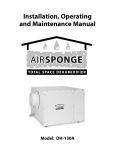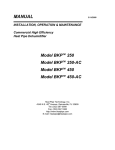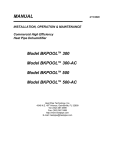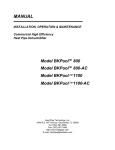Download Williams Airsponge User's Manual
Transcript
Dehumidistat Installation Instructions APPLICATION The dehumidistat (humidity controller) provides automatic low voltage control of the dehumidifier in central heating and air conditioning systems. It has a SPST, snap-acting, dust-proof switch and is designed for wall or surface duct mounting. INSTALLATION When installing the product . . . 1. Read these instructions carefully. Failure to follow them could damage the product or cause a hazardous condition. 2. Check the ratings given in the instructions and on the product to make sure the product is suitable for your application. 3. Installer must be trained, experienced service technician. 4. After installation is complete, check out product operation as provided in these instructions. Personal Injury Hazard. Power supply can cause electrical shock. Disconnect power supply before beginning installation. Location and Mounting The dehumidistat can be mounted at any convenient location in the living area or equipment room. NOTE: The electrical connections are not shared with the thermostat. Wall Mounting IMPORTANT - Mount the control in an area with average room temperature and average relative humidity. 1. Mark the holes for the two mounting screws (included). Then mark the hole for the low voltage wiring. 2. Drill the holes. 3. Run low voltage wiring to the location and pull about 6 inches (152 mm) of wire through the hole. 4. Plug the hole with nonflammable insulation to prevent drafts from affecting the control operation. 5. Remove the case from the base. 6. Position the base on the wall with the arrow up. 7. Use the two, one inch (25 mm) mounting screws to secure the base to the wall. IMPORTANT – Use 18- to 22-gauge wire for proper wiring. 8. Connect the low voltage wires to the leads. 9. Replace the case. Duct Mounting IMPORTANT – When mounting near an elbow area, locate the control six includes (152 mm) upstream from the elbow so the element is exposed to the normal airflow (Figure 1). 1. 2. 3. 4. 5. 6. 7. Locate the control at least 8 includes (203 mm) upstream from the dehumidifier in the return air duct. (See Figure 1). Apply the duct template to the duct location. Use the duct template to make the opening and mounting hole. Remove the dehumidistat case from the base. Position the foam gasket on the base. Position the base on the duct with the arrow up. Use the four, one-inch (25 mm) mounting screws to secure the base to the duct. Connect the low voltage wire to the leads. Replace the case. 8. 9. IMPORTANT – Use 18- to 22-gauge wire for proper wiring. Figure 1 - Selecting Duct Location for Control WIRING Personal Injury Hazard. Power supply can cause electrical shock. Disconnect power supply before beginning installation. All wiring must comply the applicable local codes, ordinances and regulations. Make wiring connections according to dehumidifier instructions; otherwise see typical wiring diagram in Figure 2. Figure 2 - Diagram for Dehumidifier ADJUSTMENTS Humidity Control Adjustment To maintain optimum humidity control without causing condensation on cold surfaces such as windows, the homeowner must adjust the set point as the outdoor temperate changes. To reduce the relative humidity, reduce the set point approximately three percent relative humidity every 24 hours. To increase the relative humidity increase the set point approximately three percent relative humidity ever 24 hours. Set Point Adjustment Set the humidity set point according to the prevailing outdoor temperature. See table below for recommended settings. Recommended Humidity Controller Settings Outdoor Temperature F C -20 -29 -10 -23 0 -18 +10 -12 +20 -7 >+20 >-7 Recommended Humidity Controller Setting 15 20 25 30 35 40 OPERATION AND CHECKOUT Place the system in operation and observe through at least one complete cycle to make certain that all components are functioning properly.











